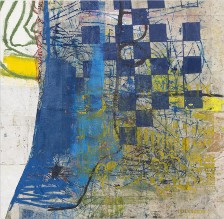
On a recent visit to Manhattan, I looked in on a half-dozen Chelsea galleries. It seems that there is a mini-trend regarding the use of line as a dominant element in the works of four of the artists whose work I saw:
Walter Darby Bannard at Berry Campbell, Jeff Elrod at Luhring Augustine, Charles Hewitt at Jim Kempner Fine Arts, and Oscar Murillo at David Zwirner.
All four artists use prominent gestural lines in their works in broadly similar ways. Why? They are not of the same generation. Bannard, who died on Oct 2 of this year, was born in 1934 and Charlie Hewitt was born in 1946—these are the old timers. Elroy on the other hand was born in 1966, and Murillo, the “youngster” was born in 1986. Barnard was known in the 50s for color field abstraction and was included in Clement Greenberg’s 1964 exhibition “Post-Painterly Abstraction.” It was only much later that he started including gestural marks in his canvases to enliven his color field-based paintings.
Charlie Hewitt came to the line via printmaking and evolved his present painterly style more recently. But he is just as well known for his sculptures which have a Miro-like playfulness.
Jumping a generation, Jeff Elrod’s lines originate from the movement of a computer mouse while working in Photoshop or Illustrator and are translated into paintings, sometimes starting with an inkjet on canvas image that is meticulously overpainted. Because of his lines’ sometimes awkward path, they often resemble graffiti. Finally Oscar Murillo presents large canvases that are filled with images of his life in Columbia overlain with obsessive scribbles (like those of a child just learning to draw). His multi-layered approach faintly evokes the texture of late Rauschenbergs. Each artist seems to have a different starting point for his lines. But they may have a similar motivation, hinted at in the evolution of Bannard’s work. His early paintings were Albers-like in their cool formalism.

The lines and marks in these late pieces humanize and personalize the paintings, making them more approachable—easier to digest and comprehend, more consumer friendly. Then the answer to “why this mini trend” seems to be found in the marketing decisions of the galleries. Friendly, emotionally approachable paintings sell more easily than difficult, more cerebral works. Even Renoir recognized this when he said that to be a financially successful painter, one has to learn to paint a pretty picture.


Volume 31 number 2, November / December 2016 p 27
